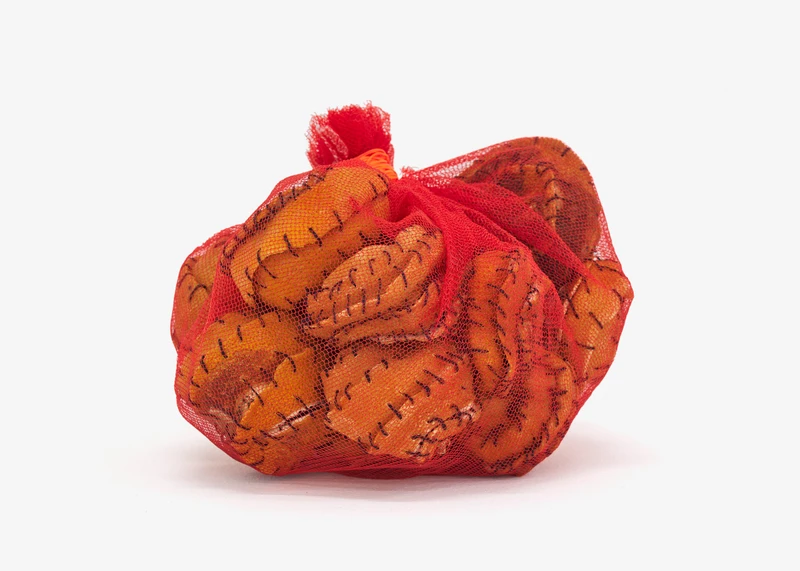Veronica Ryan


b. 1956, United Kingdom
Veronica Ryan was born in Plymouth, Montserrat (West Indes) in 1956. She studied at The School of Oriental and African Studies, London; The Slade School of Fine Art, University College, London; Bath Academy of Art, Corsham Court, UK; and St. Albans College of Art and Design.
‘There are key words which are important for me,’ Ryan told historian Sheena Wagstaff in 1993, ‘residues, traces, memory, deposits.’ Since these early stages of her career, Ryan has mined these psychological repositories, reforming the uncovered psychological sediment into sculptural objects and assemblages that reflect the natural world around her. Making reference to fruits, seeds and vegetables, as well as the containers and modular units used to transport them, Ryan positions her work at the midpoint between oppositional principles: interior and exterior, absence and presence, material and object memory.
Ryan’s interest in organic forms has remained constant since the 1980s. An early sculptural ensemble, Attempts to Fill Vacant Spaces (1986), comprises an octet of bronze pods nesting plaster flowers and husks; the Carrara marble block of Mango Reliquary (2000) is set with 20 mango stones covered in lead foil. For a forthcoming commission honouring the Windrush Generation, Ryan will create a series of marble and bronze sculptures depicting fruits and vegetables native to the Caribbean.
But while Ryan has frequently drawn upon this natural taxonomy, she has refused to define the specific connotations of such forms. Seed pods and fruits have been used interchangeably to allude to the historic circulation of produce and people; to cycles of life, death and rebirth; to concerns over environmental breakdown; as well as notions of personal history, intergenerational exchange and inherited trauma. Shack Shack (2018), a clutch of skeletal pods bound in fishing line, speaks to the acceptance of pain that recovery requires. Ryan’s works, writes Rachel Spence, ‘[are] so faithful to their physical roots yet resistant to obvious narratives.’
This fluidity of meaning is exemplary of the manner in which Ryan’s ideas float through her distinct bodies of work: everything is connected, all is in flux. (When discussing her broad practice, Ryan references the interconnectedness of root systems: ‘I think I have a subterranean way of thinking.’ ) It is for this reason that, even when Ryan reorients her focus from organic matter to man-made objects, she remains attentive to the residue and accretion of experienced life.
For ‘Compartments/Apart-ments’ (1992), Ryan’s 1995 exhibition at Camden Art Centre, London, and her first solo project since the birth of her daughters, she filled a series of cast baby-wipe boxes with an accumulation of hair, fingernails and dust. (Curator Natalie Rudd writes of this almost archaeological presentation as a ‘radical process of emptying out’ .) ‘The idea of containment and the container has been one of the essential concerns of my work’, Ryan notes, ‘capsules, divisions, compartments, all are metaphors for wider issues of dissociation, fracture, displacement, alienation’ .
In 2014, the 21 works that made up Ryan’s Camden Arts Centre exhibition were destroyed in a storage facility fire in London; Ryan described the erasure as a ‘rupture’. But ruptures can be resolved: for ‘Along a Spectrum’, Ryan’s 2021 survey at Spike Island, Bristol, certain conversations that were initiated at Camden were roused once more. For Holding Nets (2020-21), containers and paper plates were bound in netting and stored in a shelving unit; Not a Singularity (2020-21) saw doilies, orange peel, volcanic ash and other materials stacked around steel and glass tables. This subtle act, one of material and theoretical reconstitution, is indicative of Ryan’s broader process of dredging up and sifting through formative moments of lived history; of revisiting and learning from that which was lost – or that which lingers.
Ryan’s desire for order and resolution is evident in her tendency to stack, gather and bind objects together, as it is in such fabric works as Tidal (2020), Hang (2019) and Hung (2019). Ryan was first taught to sew by her mother, a skilled quiltmaker; now, she views the act of stitching as a means to metaphorically suture disconnected times. (‘The backstitch is a way to connect the past with the present’, she notes. ) But, as is often demonstrated by her work, reconciliation is complex: to stitch is to repair and puncture at once.
In a discussion with curator Jenni Lomax ahead of the exhibition ‘Donachie Rhodes Ryan’ at Freelands Foundation in 2019, Ryan spoke of her tendency to transport indiscriminate objects: ‘If you were to go through my bags, you would find all sorts of odd things: mango stones and some kind of date pit.’ She continued: ‘I’ve actually managed to germinate a date pit. […] I’m just excited about seeing whether it’s possible to germinate things outside of their natural climate.’
This curiosity over acclimatory responses to changing environments runs through Ryan’s practice as a whole: she positions personal objects, known forms and embedded memories within new contexts in order to assesses what they might become. It is a study of how things persist; how things develop; the sustenance they might one day provide. ‘I’ve always carried things around’, she says. ‘Heavy bags.’
1.Veronica Ryan and Sheena Wagstaff, Veronica Ryan: The Wood Street Gallery, 1993, (Pittsburgh: Three Rivers Arts Festival, 1993)
2.Rachel Spence, ‘Fruits of experience — the subtle work of Veronica Ryan’, Financial Times, 13 May 2021
3.Conversation with Alison Jacques Gallery, 27 April 2021
4.Natalie Rudd, ‘Attempts to Fill Vacant Spaces: The Early Work of Veronica Ryan’, Veronica Ryan: Along a 5.Spectrum (Bristol: Spike Island, 2021), pp. 8–23, p.15
6.Veronica Ryan, Compartments/Apart-ments (London: Camden Arts Centre, 1995) p.5
7.Conversation with Alison Jacques Gallery
8.‘In Conversation with Veronica Ryan and Jenni Lomax’, Freelands Foundation, London, 9 July 2019